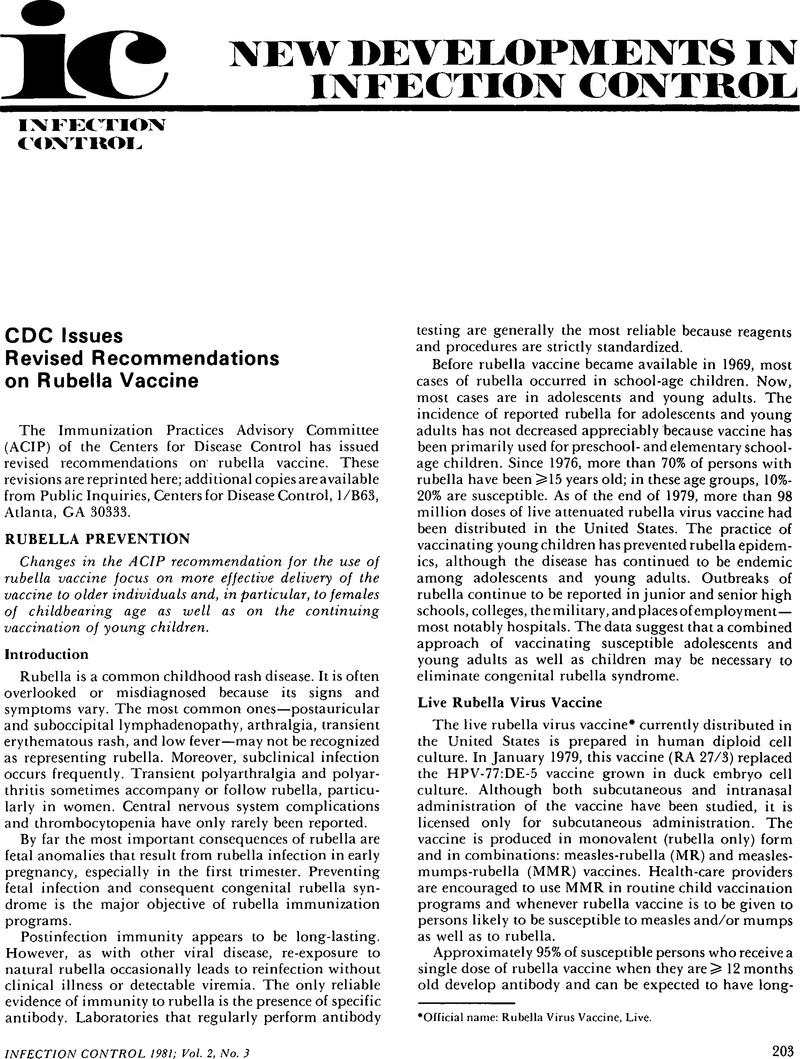No CrossRef data available.
Article contents
New Developments in Infection Control
Published online by Cambridge University Press: 02 January 2015
Abstract
An abstract is not available for this content so a preview has been provided. Please use the Get access link above for information on how to access this content.

- Type
- Departments
- Information
- Copyright
- Copyright © The Society for Healthcare Epidemiology of America 1981
References
Selected Bibliography
Bernstein, DI, Ogra, PL. Fetomaternal aspects of immunization with RA 27/3 liveattenuated rubella virus vaccine during pregnancy. J Pediatr 1980;97:467–70.CrossRefGoogle Scholar
Buimovici-Klein, E, Hite, RL, Byrne, T, Cooper, LZ. Isolation of rubella viruses in milk after postpartum immunization. J Pediatr 1977:91:939-41.CrossRefGoogle ScholarPubMed
Cooper, LZ, Krugman, S. The rubella problem. DM 1969 Feb:3-38. CDC. Rubella—United States 1977-1980. MMWR 1980:29:378-80.Google Scholar
Farquhar, JD. Followup on rubella vaccinations and experience with subclinical reinfection. J Pediatr 1972;81:460–5.CrossRefGoogle ScholarPubMed
Furukuwa, T, Miyata, T, Kondo, K, Kuno, K, Isomura, S, Takekoshi, T. Clinical trials of RA 27/3 (Wistar) rubella vaccine in Japan. Am J Dis Child 1969;118:262–3.Google Scholar
Hayden, GF, Herrmann, KL, Buimovici-Klein, E, Weiss, KE, Nieberg, PL, Mitchell, JE. Subclinical congenital rubella infection associated with maternal rubella vaccination in early pregnancy. J Pediatr 1980;97:869–72.CrossRefGoogle Scholar
Herrmann, KL, Halstead, SB, Brandline-Bennett, AD, Witte, JJ, Wiebenga, XH, Eddins, DL. Rubella immunization persistence of antibody 4 years after a large-scale field trial. JAMA 1976:235:2201–4.CrossRefGoogle Scholar
Hillary, IB, Griffith, AH. Persistence of antibody 10 years after vacci nation with Wistar RA 27/3 strain live attenuated rubella vaccine. Br Med J 1980;224:1580–2.CrossRefGoogle Scholar
Horsimann, D. Controlling rubella: problems and perspective. Ann Intern Med 1975;83:412–7.CrossRefGoogle Scholar
Klein, EB, Byrne, T, Cooper, LZ. Neonatal rubella in a breast-fed infant after postpartum maternal infection. J Pediatr 1980;97:774–5.CrossRefGoogle Scholar
Krugman, S. Present status of measles and rubella immunization in the United States: a medical progress report. J Pediatr 1977;90:1–12.CrossRefGoogle ScholarPubMed
Landes, RD, Bass, JW, Millunchick, W, Oetgen, WJ. Neonatal rubella following postpartum maternal immunization. J Pediatr 1980;97:465–7.CrossRefGoogle ScholarPubMed
Marymont, JH, Herrmann, KL. Rubella in pregnancy; review of current problems. Postgrad Med 1974;56:167–72.CrossRefGoogle ScholarPubMed
McLaughlin, MC, Gold, LH. The New York rubella incident: a case for changing hospital policy regarding rubel la testing and immunization. Am J Public Health 1979;69:287–9.CrossRefGoogle Scholar
Polk, BF, White, JA, DeGirolami, PC, Modlin, JF. An outbreak of rubella among hospital personnel. N Engl J Med 1980;303:541–5.CrossRefGoogle ScholarPubMed
Preblud, SR, Serdula, MK, Frank, JA, Brandling-Bennett, AD, Hin man, AR. Rubella vaccination in the United States: a ten-year review. Epidemiologic Reviews 1980;2:171–94.CrossRefGoogle ScholarPubMed
Weibel, RE, Buynak, EB, McLean, AA, Roehm, RR, Hilleman, MR. Persistence of antibody in human subjects 7 to 10 years fol lowing administration of combined live attenuated measles, mumps, and rubella virus vaccines. ProcSoc Exp Biol Med 1980;165:260–3.CrossRefGoogle Scholar


